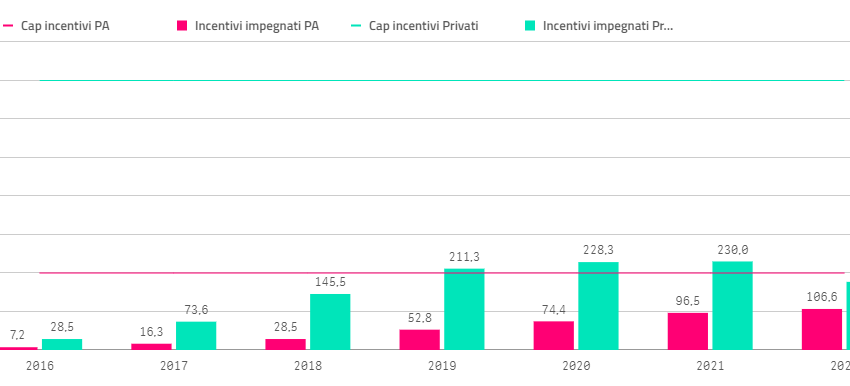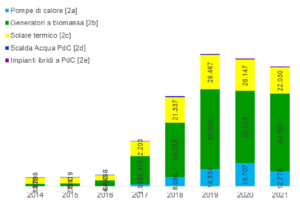Conto Termico: Good incentive but with room for improvement
April 25, 2023
Conto Termico, the Italian national support scheme for renewable heating, has had an important impact on the solar thermal market. 83 % of the newly installed collector area between 2016 and 2021 received subsidies from the national scheme. This can be calculated by comparing the cumulative figures from a report by GSE, the Italian state-owned company managing Conto Termico, with the market volume. One plus point of the programme is definitely the consistently good financial resources. This prevented any stop-and-go effect, which often occurs in other countries when there is a lack of funding. One of the programme’s weaknesses, however, is certainly the fact that the expansion of large-scale solar thermal systems is not making any progress.
Screenshot from https://www.gse.it/contatore-conto-termico
Conto Termico has a large budget that is only partially used (see figure above). According to the “real-time counter” for Conto Termico on the GSE website, the available budget for private households has been EUR 700 million for each of the last years (green line) plus an additional EUR 200 million for applications from the public sector (red line). The private budget was used by around a third over these years. The most recent use of funds in the public sector was 53 %.
Figure 1 shows the annual applications approved for Conto Termico. There was a steep increase in the years 2017 to 2019 after the revision in 2016 resulting in improved funding conditions under Conto Termico 2.0.
The stagnating number of applications in 2020 and 2021 must be seen in the context of the Superbonus programme, which allowed investors a 110 % tax reduction for any energy efficiency measures, including new heating systems. It is a positive sign that despite the attractive Superbonus, the number of applications for Conto Termico has remained relatively high.

Figure 1: Number of applications for renewable heat support from Conto Termico between 2013 and 2021. Blue is heat pumps, green is biomass boilers, yellow is solar thermal, dark blue is for hot water heat pumps and purple for other types of heat pumps. Source: GSE, October 2022
Solar thermal covers only a small proportion of the heat market
According to the GSE statistical report for 2022, solar heat in 2020 covered a heat demand of almost 10,000 terajoules, representing 2.5 % of all the renewable heat, which corresponds to a solar thermal stock of slightly less than 4.5 million m2 installed in the country. Around 76 % of this solar heat went to the residential sector, while 18 % supplied commercial customers. Only 6 % of the total heat production therefore went to consumers in the industrial and agricultural market segments.
83 % of total market volume is subsidised
More details about the effects of the Conto Termico scheme on the solar heat market were provided during the national round table organised as an online event by the Renewable Heating and Cooling European Technology Innovation Platform (RHC-ETIP) at the end of October 2022.
Alessandro Pellini from GSE also presented aggregated figures: Conto Termico subsidised 895,000 m2 of collector area between 2016 and 2021. In these six years a total of 1,076,598 m2 were newly installed according to market figures from the association Anima. So 83 % of the total market volume was subsidised, which is a significantly higher share than in other countries with long-term national subsidy schemes such as Germany.
|
895,000 m2 of subsidised collector area between 2016 and 2021 |
|
| Share of flat plate collectors in this total | 82 % |
| Average size of the subsidised solar thermal systems in this total | 6.5 m2 / system |
| Share of thermosiphon systems in this total | 60 % |
Long-term statistics for solar thermal subsidised by Conto Termico. Source: GSE
Much more could be done
As evidenced by the above figures, much more could be done to promote the use of Conto Termico, especially in the market sectors where medium and large-scale solar thermal plants could be used, for example for industrial customers or in district heating networks. This is even more significant because the effect of the incentive could be really strong for large plants, covering 40 % to 65 % of the investment cost.
Although some good signals are coming from the market, for example, the installation of two solar district heating plants in the networks of Turin and Verona last year, the more advanced applications for solar thermal technology still need a lot more awareness raising and communication activities.
Conto Termico could also be improved
To confirm this statement, it is useful to have a look at the interactive online map Atlaimpianti developed by GSE to show all the installations that received the Conto Termico incentive. The map includes data until July 2021. If solar thermal technology is selected and a filter is included to show only plants with an aperture area larger than, for example, 300 m2, only 8 systems appear in the list, ranging from slightly more than 300 m2 to almost 1,500 m2 for a solar cooling plant in the north-east of Italy.
Apart from awareness-raising campaigns, the situation could also be improved by lifting the threshold which, at the moment, limits the support from Conto Termico to solar heat plants up to 2,500 m2. This means that exceeding this limit, even by a very small amount, implies losing the whole incentive.
Recently, in a solar thermal workshop organised at the Key Energy fair by a new Italian solar heat association now being founded, named Solterm Italia, a practical proposal was made for improving the mechanism: plants larger than 2,500 m2 could also apply for the incentive but it would only be granted for 2,500 m2 of collectors and not for the additional collector area.
Websites of organisations mentioned in this news article:
GSE counter for Conto Termico: https://www.gse.it/contatore-conto-termico
Atlaimpianti: https://atla.gse.it/atlaimpianti/project/Atlaimpianti_Internet.html
Anima: https://www.anima.it/associazioni/elenco/assotermica/


